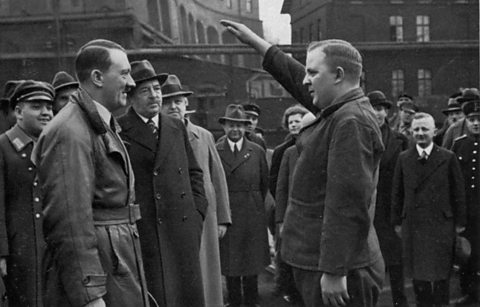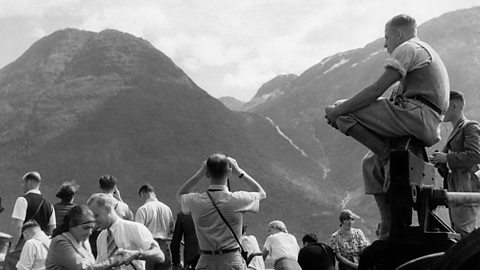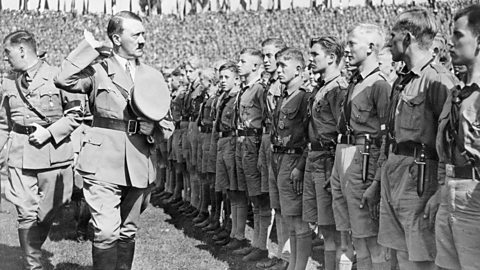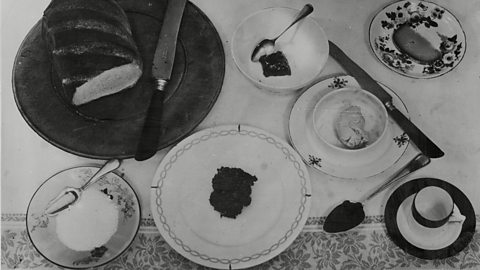Creating jobs

Hitler aimed for full employment and self-sufficient For a country to be able to provide what is needed for itself, without relying on others. for the German people through a variety of methods.
A huge part of the NazisвҖҷ appeal in the elections in 1933 was that they promised вҖңbread and workвҖқ and to make GermanyвҖҷs economy strong again.
Hitler used a variety of methods to try to create jobs for the six million Germans unemployed in 1933.
Public works and the National Labour Service (RAD)
HitlerвҖҷs first Economic Minster, Dr Hjalmar Schacht, expanded the public works schemes of the Weimar RepublicThe name given to the German republic between 1919 and 1933. and set up the National Labour Service (RAD).
The RAD used unemployed men between the ages of 18 and 25 to build government-funded motorways, hospitals, schools and other public buildings.
The men spent six months in camps, wore uniforms and received a small amount of pay to send back to their families.
The RAD became compulsory for men in 1935.
Question
Why was the RAD useful to the Nazi regime?
The RAD was beneficial to the Nazis because it provided them with cheap labour, reduced the numbers on the unemployment register, led to a network of motorways which could be used for the mobilisation of the army during the war and kept young people occupied.
Conscription
From 1935 onwards, young men between the ages of 18 and 25 were conscriptionCompulsory enrolment in the armed forces. into the army for two years.
Rearmament
Millions of jobs were created in factories producing new weapons. This process started almost as soon as Hitler came to power.
Removal of people from jobs
Many groups of people, for example Jews and professional women, were excluded from work, which left vacancies for others.
These groups were taken off the unemployment register which made the employment statistics artificially better.
The New Plan

Dr Schacht, HitlerвҖҷs first Minister of the Economy, established the New Plan in 1934, with the aim of getting Germany out of economic depression.
It prioritised government resources for industry and cut welfare spending.
By 1936, the economy was recovering.
But Hitler wanted a more dramatic transformation and appointed Hermann Göring to make Germany ready for war.
This policy, known as autarky, was to ensure GermanyвҖҷs economy was self-reliant during a war.

Question
What does вҖҳautarkyвҖҷ mean?
Autarky meant self sufficiency for Germany; that it would be able to survive by itself economically.
Hitler wanted a strong and independent Germany. Therefore, the country had to be self-sufficient in both food and materials.
In order to achieve вҖңautarkyвҖқ the Nazis:
- Limited imports.
- Made trade agreements with other countries.
- Set targets to increase the production of oil, rubber and steel.
- Ordered German scientists to develop synthetic and artificial substitutes in order to reduce the need for imports.
The Four Year Plan
Göring dramatically altered the pace of change in the German economy by bringing about his Four Year Plan.
The measures Göring introduced targeted both agriculture and industry. They included:
- The establishment of the Reich Food Estate: It strictly regulated what farmers could produce, guaranteed prices for farmersвҖҷ produce and gave subsidiesMoney given by the government or organisation to help a business keep the price of a product or service low. to encourage more food production.
- Tighter controls on imports.
- Production of ersatz (i.e. synthetic substitutes for materials which were in short supply).
- Forced labour by the inmates in the concentration camps.
- Building huge industrial complexes.
Question
What were some examples of ersatz products?
The Nazis attempted to use coal to make oil and rubber, acorns to manufacture coffee, paper pulp to produce fabric and flour to create make-up.
Economic impact by 1939
Overall, the economic results of HitlerвҖҷs policies were mixed.
At first glance, it appears the Nazis were very successful, however this was not entirely the case.
Successes
- SchachtвҖҷs New Plan helped the German economy recover from the Great DepressionA global economic crisis that started in 1929 in the USA. It led to mass unemployment and hardship throughout the 1930s. within two years.
- By 1939, there was virtually no official unemployment in Germany.
- It had a modern motorway network and new public buildings.
- It had rearmed its military.
Failures
Although Hitler appeared to have solved unemployment and made Germany look prosperous, there were serious problems in the economy.
- autarkyA closed economy. Hitler's ideology that wanted Germany to cease trade with the outside world and rely entirely on its own resources. was not successful; Germany was still importing 20 per cent of its food and 33 per cent of its raw materials.
- The economy was not ready for a long war in 1939.
- ersatzGoods that are made or used as a substitute for something else, usually of poor quality. were more expensive and inferior to the products they replaced.
- Germany had rearmed in breadth but not in depth; it had great variety of armaments but limited numbers of each type.
- There was a huge national debtMoney that a country has borrowed and will have to pay back. .
- There was a serious shortage of agricultural workers because of the drift of poverty-stricken peasants to the towns.
Nazi attempts to change the lives of workers
The Nazis set up three groups to ensure the loyalty and obedience of workers:
The German Labour Front (DAF)
This was the Nazi organisation that replaced trade unions, which were banned in May 1933 because they could interfere with HitlerвҖҷs plans.
It was run by Dr Robert Ley.
Workers could not strike, bargain for wages or leave their jobs without permission.
The DAF nearly always followed the wishes of employers, rather than employees.
The maximum working hours per week were increased from 60 to 72, and workers could not change their jobs without permission.
Strength Through Joy (KdF)

This scheme was set up in November 1933.
Its aims were to make workers support Hitler by offering them rewards and to keep them occupied outside the workplace with organised leisure activities.
It was also run by Dr Ley.
Activities and rewards included:
- Evening classes
- Theatre trips
- Picnics
- Broad range of mass participation sporting events
- Very cheap or free holidays. There were walking holidays in Switzerland and skiing holidays in Bavaria. Two big cruise liners were built to sail people around the Canary Islands for only two weeksвҖҷ wages.
The KdF also started a savings scheme for workers who wanted to buy the Volkswagen Beetle, known as the вҖңPeopleвҖҷs CarвҖқ.
They were to save 5 marks per week until 750 marks had been paid into the scheme.

Beauty of Labour (SdA)
The role of this organisation was to help Germans see that work was good and that everyone who could work should do so.
It also encouraged factory owners to improve conditions for workers, for example better lighting and washing facilities.
Impact on the lives of German workers

Successes
- Despite the loss of freedom, life improved in Germany for some ordinary people.
- 60,000 new houses were built and rent and price controls helped consumers.
- People enjoyed the very varied activities of the Strength Through Joy (KdF)A Nazi organisation set up to organise leisure activities. .
- There was full employment.
- The number of unemployed dropped from six million in 1933 to an actual labour shortage by 1939.
- Wages for most workers eventually improved slightly.
Failures
- Workers had lost the right to negotiate wages, to strike and to change jobs freely.
- The living standards of German workers in the non-armaments industries did not really improve.
- Few people actually got to go on cruises.
- No one received a вҖңPeopleвҖҷs CarвҖқ. When war broke out in 1939, car production was axed and replaced with the making of tanks.
- The maximum working hours per week increased from 60 to 72.
- They could not change their job without permission.
- There was also a lot of hidden unemployment, for example among the Jews.
- Initially less women were employed and it tended to be mainly in manual jobs or low paid agricultural work.
The effectiveness of Nazi policies by 1939
Hitler had an almost obedient workforce.
For example, they accepted the ending of trade unions which had protected their rights.
They worked longer hours and had to ask permission to change their job.
However, control of the workers was not completely successful.
The workers were more enthusiastic about the Strength Through Joy (KdF)A Nazi organisation set up to organise leisure activities. than DAFGerman Labour Front.
Some workers and employers were remarkably successful at getting around Nazi restrictions.
There was also some persistent opposition by ordinary German workers, often helped by communists.
They posted anti-Nazi posters and graffiti, or organised strikes even though they were illegal.
Test your knowledge
More on Life in Nazi Germany, 1933-45
Find out more by working through a topic
- count5 of 7

- count7 of 7
